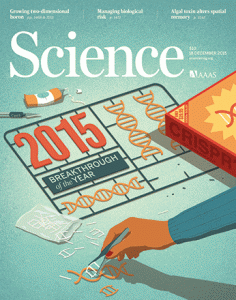 Science magazine has issued an expression of concern for a paper on the discovery of a new immune-boosting protein. The paper’s findings, which received some press coverage when they came out last spring, are now under investigation by Imperial College London.
Science magazine has issued an expression of concern for a paper on the discovery of a new immune-boosting protein. The paper’s findings, which received some press coverage when they came out last spring, are now under investigation by Imperial College London.
The expression of concern follows a correction noting a Western blot mix-up. Science Editor in Chief Marcia McNutt told us last month that the mistake resulted from “carelessness” on the part of the authors. But now, an investigation at Imperial College London — where Philip Ashton-Rickardt led the research — is formally looking into the findings.
That investigation is ongoing, according to the expression of concern (signed by McNutt):
In the 29 May 2015 issue, Science published the Research Article “The protein LEM promotes CD8+ T cell immunity through effects on mitochondrial respiration” by I. Okoye et al. (1). On 23 October 2015, Science published a Correction to two of the figures in the Okoye et al. paper (2). An investigation into potential errors in the paper is being undertaken by Imperial College London, UK. In light of the continuing investigation, Science is publishing this Editorial Expression of Concern to alert our readers to the fact that questions have been raised about the validity of findings in the Okoye et al. paper.
The paper has been cited three times, according to Thomson Scientific’s Web of Knowledge.
After the correction was published, we asked McNutt if there was any indication of misconduct. On November 11th, she told us:
Science does not have sufficient evidence at this time to request that an investigation into scientific misconduct be launched, as the corrections to the figures did not change the conclusions of the paper. In any case such an investigation would need to be undertaken by the authors’ institutions.
This week, McNutt told us she did eventually request an investigation, but one had already begun:
I wrote to the Scientific Integrity Officer at Imperial College on December 1, 2015, requesting an official investigation into the allegations that continued to be made of misconduct concerning the below-referenced paper even after the authors made the correction to the figures. The corresponding author, Dr. Ashton-Rickardt, contacted us the next day to let us know that Imperial College had automatically triggered an inquiry as soon as the correction had been published. The university can let you know the status of the investigation. We heard back from the university that the investigation is still underway, but not that it has concluded.
We asked McNutt what had changed between her telling us there wasn’t “sufficient evidence” to request an investigation, and then requesting one:
Nothing changed from the materials available to Science. We saw that allegations of misconduct continued to be made on public postings. We felt that it was in the best interests of the readers and of the authors that there be a formal investigation so that these concerns be investigated and either put to rest or confronted by the university and the authors so that the matter could reach some sort of resolution.
Indeed, there are several comments critical of the paper on PubPeer.
A spokesperson for Imperial College London told us that the fact that there was an investigation into the paper “is not, in itself, significant:”
Philip Ashton-Rickardt’s Science paper is being investigated because of concerns raised about the paper and the corrections made to the paper. No other papers are being investigated. The fact that the College is investigating these concerns is not, in itself, significant. The College investigates any allegation of potential research misconduct fully.
Investigations are conducted as expeditiously as possible, but must also be thorough. Because of this, it is impossible to give a definitive timetable for the completion of the investigation. The College will make public the outcome of the investigation, once it has been concluded.
We’ve reached out to Ashton-Rickardt. We will update this post with anything else we learn.
Like Retraction Watch? Consider making a tax-deductible contribution to support our growth. You can also follow us on Twitter, like us on Facebook, add us to your RSS reader, and sign up on our homepage for an email every time there’s a new post. Click here to review our Comments Policy.
Why is it always the Western blots?
It is always WBs, because if you fake WBs, it can be (sometimes) recognized. If one fakes data presented as numbers/column graph etc., nobody can realize. It means that all the retractions with faked WBs are just a tip of the iceberg.
So tired of the “Western blot mix-ups”. I was a first author. I took all the images for everything. I saw them, and I saved each file with a description of what it was. I don’t believe that a first author has a “mix-up” – only results that wouldn’t look interesting to a journal. A first author knows what the images look like.
“Science does not have sufficient evidence at this time to request that an investigation into scientific misconduct be launched, as the corrections to the figures did not change the conclusions of the paper.”
Hmmm. Does this mean — not talking about this case here, just in general — that if I fake data, it’s only misconduct if the conclusions of the paper depend on that data?
If a scientist fakes data and there are no conclusions around to hear it, does it make a sound?